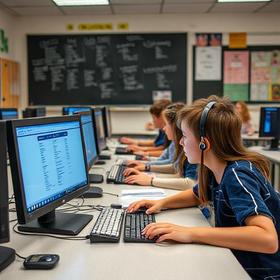Margaret C Ells serves 138 students in grades Prekindergarten.
The student-teacher ratio of 9:1 is lower than the Massachusetts state level of 12:1.
Minority enrollment is 92% of the student body (majority Hispanic), which is higher than the Massachusetts state average of 47% (majority Hispanic).
Quick Facts (2025-26)
- Grades: Prekindergarten
- Enrollment: 138 students
- Student-Teacher Ratio: 9:1
- Minority Enrollment: 92%
- Source: National Center for Education Statistics (NCES), MA Dept. of Education
Top Rankings
Margaret C Ells ranks among the top 20% of public schools in Massachusetts for:
Category
Attribute
Percent Eligible For Free Lunch
Community Size
Student Attention
School Overview
Margaret C Ells's student population of 138 students has declined by 39% over five school years.
The teacher population of 16 teachers has stayed relatively flat over five school years.
Grades Offered
Grades Prekindergarten
(Supplemental Virtual)
(Supplemental Virtual)
Total Students
138 students
Gender %
Total Classroom Teachers
16 teachers
School Calendar
School Rankings
The diversity score of Margaret C Ells is 0.49, which is less than the diversity score at state average of 0.65. The school's diversity has stayed relatively flat over five school years.
Student-Teacher Ratio
9:1
12:1
American Indian
n/a
n/a
Asian
1%
7%
Hispanic
69%
25%
Black
15%
10%
White
8%
53%
Hawaiian
n/a
n/a
Two or more races
7%
5%
All Ethnic Groups
Participates in the National School Lunch Program (NSLP)
Yes
Eligible for Free Lunch
100%
35%
Eligible for Reduced Lunch
15%
4%
School Statewide Testing
School District Name
Source: National Center for Education Statistics (NCES), MA Dept. of Education
Profile last updated: 02/09/2025
Frequently Asked Questions
How many students attend Margaret C Ells?
138 students attend Margaret C Ells.
What is the racial composition of the student body?
69% of Margaret C Ells students are Hispanic, 15% of students are Black, 8% of students are White, 7% of students are Two or more races, and 1% of students are Asian.
What is the student-teacher ratio of Margaret C Ells?
Margaret C Ells has a student ration of 9:1, which is lower than the Massachusetts state average of 12:1.
What grades does Margaret C Ells offer ?
Margaret C Ells offers enrollment in grades Prekindergarten (Supplemental Virtual).
What school district is Margaret C Ells part of?
Margaret C Ells is part of Springfield School District.
In what neighborhood is Margaret C Ells located?
Margaret C Ells is located in the Bay neighborhood of Springfield, MA. There are 1 other public schools located in Bay.
School Reviews
5 10/10/2025
good morning,my name is Irene malave,my son Michael b rios has been assigned to Margaret c ells elemantery school.i've never heard of the school.went to look at it today,so far I like the area,its clean,quiet,very nice.so far secure with cameras,which its every parents concern,so far I approve,but still doing my research on it. have a good day
Review Margaret C Ells. Reviews should be a few sentences in length. Please include any comments on:
- Quality of academic programs, teachers, and facilities
- Availability of music, art, sports and other extracurricular activities
Recent Articles

Cybersecurity in U.S. Public Schools 2025: Risks, Policies & Protection
Explore the 2025 state of cybersecurity in U.S. public schools, updated data, expert insights, policy moves, and how schools and families can stay safe.

The Rise of STEM in Public Schools: 2025 Update
Explore how STEM is transforming U.S. public schools in 2025鈥攖rends, policies, programs, and what parents and educators should know.

How Public Schools Support Mental Health in 2025
Explore how U.S. public schools are supporting student mental health in 2025鈥攑rograms, results, challenges and strategies for educators, parents and policymakers.





